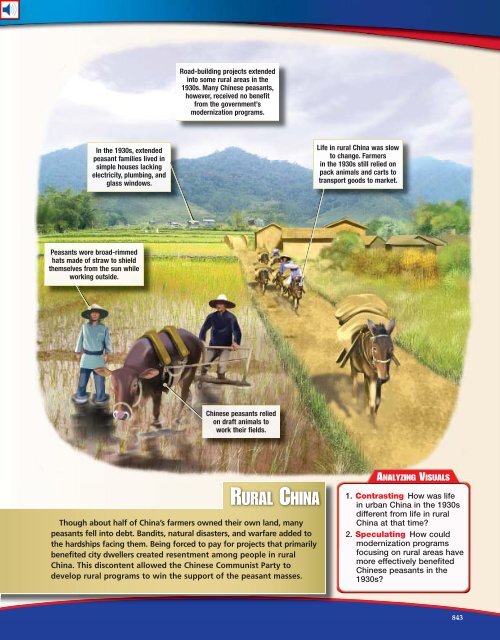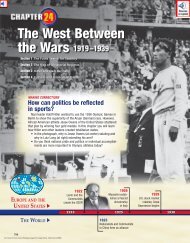Road-building projects extendedinto some rural areas in the1930s. Many Chinese peasants,however, received no benefitfrom the government’smodernization programs.In the 1930s, extendedpeasant families lived insimple houses lackingelectricity, plumbing, andglass windows.Life in rural China was slowto change. Farmersin the 1930s still relied onpack animals and carts totransport goods to market.Peasants wore broad-rimmedhats made of straw to shieldthemselves from the sun whileworking outside.Chinese peasants reliedon draft animals towork their fields.RURAL CHINAThough about half of China’s farmers owned their own land, manypeasants fell into debt. Bandits, natural disasters, and warfare added tothe hardships facing them. Being forced to pay for projects that primarilybenefited city dwellers created resentment among people in ruralChina. This discontent allowed the Chinese Communist Party todevelop rural programs to win the support of the peasant masses.ANALYZING VISUALS1. Contrasting How was lifein urban China in the 1930sdifferent from life in ruralChina at that time?2. Speculating How couldmodernization programsfocusing on rural areas havemore effectively benefitedChinese peasants in the1930s?843
Nationalism in Latin AmericaGUIDE TO READINGThe BIG IdeaOrder and Security In Latin America, theGreat Depression made politics unstable, and inmany cases, military dictatorships were the result.Content Vocabulary• oligarchy (p. 847)Academic Vocabulary• investor (p. 844) • establish (p. 847)People, Places, and Events• Argentina (p. 844)• Chile (p. 844)• Brazil (p. 844)• Peru (p. 844)• Mexico (p. 844)• Juan Vicente Gómez(p. 845)• Good Neighbor policy(p. 845)• Hipólito Irigoyen(p. 847)• Getúlio Vargas (p. 847)• InstitutionalRevolutionary Party(PRI) (p. 847)• Lázaro Cárdenas(p. 847)• PEMEX (p. 848)• Diego Rivera (p. 849)Reading StrategySummarizing Information As youread, make a chart like the one below listing themain exports of Latin America.CountryExportsINDIANA ACADEMIC STANDARDSWorld History and Civilization9.4 Explain issues and problems of the past byanalyzing the interests and viewpoints of thoseinvolved.During the 1920s, U.S. investors poured funds directly intoLatin American businesses. The Great Depression devastatedLatin America’s economy and created instability. This turmoilled to the creation of military dictatorships and authoritarianstates in Latin America in the 1930s.The Latin American EconomyDuring the 1920s and 1930s, foreign investments and the GreatDepression led some Latin American nations to emphasize domestic industry tobalance the economy.HISTORY & YOU Have you ever enjoyed a banana split? Most likely, the bananacame from Latin America. Read to learn about Latin America’s changing economicrelationship with the United States.At the beginning of the twentieth century, the Latin Americaneconomy was based largely on the export of foodstuffs and rawmaterials. Some countries relied on only one or two products forsale abroad. Argentina, for example, exported beef and wheat;Chile, nitrates and copper; Brazil and Caribbean nations, sugar; andCentral America, bananas. A few reaped large profits from theseexports. For most of the people, however, the returns were small.Role of the United StatesBeginning in the 1920s, the United States began to replace GreatBritain as the major investor in Latin America. British investorshad put money into stocks and other forms of investment thatdid not give them direct control of the companies. U.S. investors,however, put their funds directly into production facilities andactually ran the companies. In this way, large segments of LatinAmerica’s export industries fell into U.S. hands. A number ofsmaller Central American countries became independent republics.However, their economies often depended on wealthynations. The U.S.-owned United Fruit Company, for example,owned land, packing plants, and railroads in Central America.American firms also gained control of the copper-mining industryin Chile and Peru, as well as of the oil industry in Mexico,Peru, and Bolivia.Many Latin Americans resented U.S. control of Latin Americanindustries. A growing nationalist awareness led many of them toview the United States as an imperialist power. It was not difficultfor Latin American nationalists to show that profits from U.S.businesses were sometimes used to keep ruthless dictators in844



